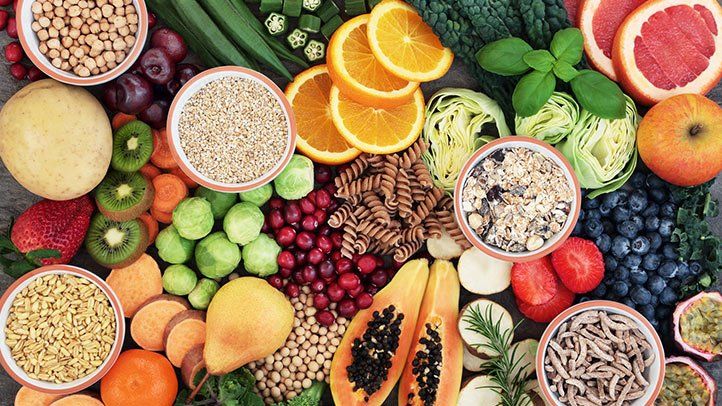This is the second post of an seven-part series about the nutrients our body needs to survive and the foods we get those nutrients from. Today the focus is on carbohydrates.
Carbohydrates and grains currently have a bad reputation in the diet world. The current diet trend is low carb. Diets like Atkins, the South Beach diet and the Keto diet all follow low carb protocols. Diets like the paleo diet or the Whole 30 diet tell you to cut out grains because they are not a “natural” part of the diet. A lot of times when people want to lose weight, the first thing they do is cut down their carb intake, which usually means they don’t eat bread and pasta. The problem is that our body’s main source of fuel comes from carbohydrates. Carbohydrates are not bad. They are necessary for our body to function in a healthy way. Where your carbs come from and how much you eat is what is important. To understand why, lets go over some basics of carbohydrates.
Carbohydrate structure
A carbohydrates is a compound with one or more sugars. Carbohydrates are often classified into simple and complex carbohydrates. Simple carbohydrates, have one or two sugars. Simple carbohydrates are also called simple sugars. There are 6 types of simple sugars, 3 monosaccharides (one sugar) and 3 disaccharides (two sugars). The monosaccharides are: glucose, fructose, and galactose. When two monosaccharides join together, they make a disaccharide. The 3 disaccharides are maltose, sucrose, and lactose. Sucrose is table sugar. Lactose is found in milk. Maltose is not often found in nature, it is found in the body during digestion and is also used as a food additive.
Long chains of carbohydrates are called complex carbohydrates, or polysaccharide (many sugars). Polysaccharides are made up of many glucose units, up to several thousand! There are three main types of complex carbohydrates. Starch, found in plants, is how plants store energy. Animals, including humans, store carbohydrates in long chains called glycogen. Fiber is a structural competent in plants.


How carbohydrates are digested and used in the body
During digetstion, ccarbohydrates are broken down into the individual sugar molecules then are absorbed into the bloodstream. From there, they are either used right away by cells for energy or stored in the muscle or liver as glycogen for use later. The glycogen in the liver is responsible for maintaining our blood sugar levels within the normal range. The liver can store about 80g of carbohydrates, or about 320 calories. Carbohydrate storage is very limited when comparted to fat storage, therefore we must eat carbohydrates on a regular basis to maintain our blood sugar. The glycogen stored in muscles can only be used by that muscle for energy, it cannot help with blood sugar levels.
When our liver runs out of glucose, or when someone is on a low carb diet, the body uses other molecules for energy. Protein and fat can be broken down and converted into substances called ketones that can be used for energy in place of glucose. Most cells in our body can use ketones as fuel. However, the brain cannot. The brain can only use glucose as fuel. You may notice when you haven’t eaten in a while you get sleepy, have a headache, or can’t focus. This is because your brain doesn’t have enough fuel to function properly. The brain alone uses 130-200g of carbohydrates per day! This is also why when you go a long time with out eating, you often want a large amount of sugar or carbs, the brain is telling you to give it fuel!
Fiber is not digestible in the human body, it simply passes through the intestines. However, it is important for our health for many reasons. Fiber can be broken down by the bacteria living in our gut and provides them with fuel. This helps keep our gut healthy, which also protects the health of the rest of our body. Fiber also adds bulk and fluid to our stool to help with easy and regular bowel movements. Fiber also helps control cholesterol levels. Fiber helps regulate blood sugar by slowing down the release of sugar into the blood. Fiber can also help us feel full and satisfied which can help with weight regulation. In addition, fiber helps prevent diseases like diabetes, heart disease, and colon cancer.
Food sources of carbohydrates

Many of the food groups contain carbohydrates. Grains, fruits, vegetables, and dairy all contain carbohydrates. Most carbohydrate rich foods contain both complex and simple carbohydrates. Grains have starch and fiber and a small amount of naturally occurring sugar. Fruits have naturally occurring glucose, fructose, sucrose and fiber. Some fruits, such as bananas, also have starch. Vegetables have a small amount of glucose, fructose, and sucrose along with fiber. Green vegetables have little to no starch, while root vegetables such as potatoes and carrots have more starch. Dairy contains carbohydrates in the form of naturally occurring lactose.
Some protein foods contain carbohydrates. Plant protein foods, such as nuts, seeds, beans, and legumes contain fiber as well as starch. Meat does not contain carbohydrates, the glycogen stored in animal muscle breaks down quickly once the animal is slaughtered.
How much, and what, to eat
For a standard 2,000 calorie diet, that’s about 900 to 1,300 calories from carbohydrates. Carbs have 4 calories per gram, so that comes out to 225 to 325g of carbs per day. This of course is a very general recommendation. If you eat more or less than 2,000 calories in a day, or are a very active person, your needs may be different.
Aim to get a variety of carbohydrates, focusing on whole food forms of carbs: whole fruits, whole vegetables, and whole grains. Within the carbohydrate recommendations, there are also recommendations for how much fiber and added sugar to eat. As stated above, fiber helps our body in many ways. Women should aim to get at least 21-25g/day while men should aim for 30-38g/day. If you are focusing on the whole foods mentioned above, it should be relatively easy to get that much fiber. However, the average American is not eating enough fiber!

Added sugars in the diet should be limited. This is because most foods with added sugar do not contain many other nutrients. When you eat a piece of fruit, which contains naturally occurring sugars, you are also getting vitamins, minerals, fiber, antioxidants and phytochemicals. Foods with added sugar often contain little to no other nutrients. For example, soda or sugary drinks, contain only calories and a large dose of sugar! The recommendation for added sugars is no more than 5-10% of your calories. The American Heart Association recommends that women to get no more than 25g per day, or about 6 teaspoons. Men should stay below 36g or about 9 teaspoons. Again, if you are focusing on getting your carbohydrates from whole foods, you won’t have to worry about checking for added sugars!
If you want more information, have questions, or are curious to know how to fill your diet with healthy carb choices, make an appointment with your local dietitian. They can help you understand which foods are right for you!
Come back next week when I will focus on fats.
Stay healthy!
Lisa Robinson-Mihiar, RDN, LD
ClubWorx Dietitian
Have a question you want Lisa to answer on the blog? Send your questions and ideas to Lisa at lrobinson (at) clubworx.net


